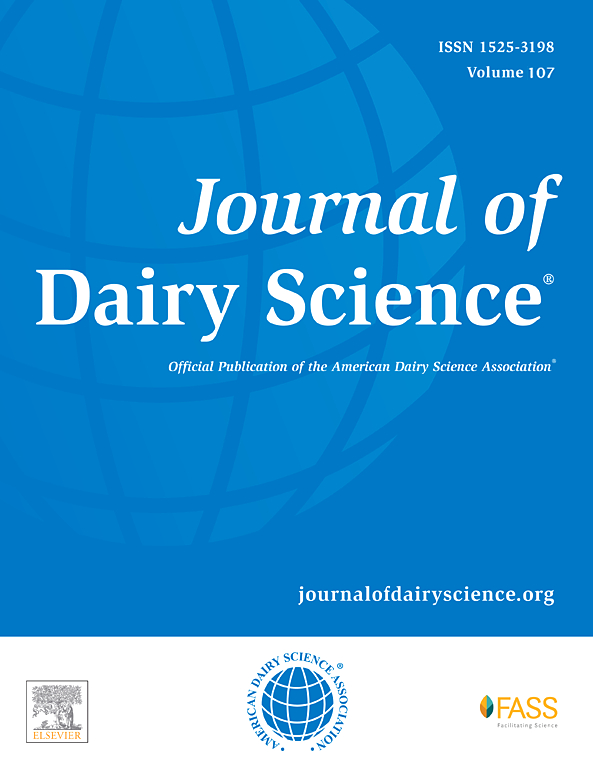培训奶牛场工作人员对遵守挤奶程序、乳房健康和牛奶质量的影响。
IF 3.7
1区 农林科学
Q1 AGRICULTURE, DAIRY & ANIMAL SCIENCE
引用次数: 0
摘要
在各种牧场程序中,适当的挤奶程序对减少乳腺炎、提高牛奶安全和质量至关重要。然而,挤奶程序未得到充分遵守仍是造成不同牛群牛奶质量差异的主要因素。培训牧场工人对确保遵守挤奶程序至关重要,挤奶程序直接影响牛奶质量和乳房健康。在本研究中,我们旨在评估培训课程对奶牛场工人对挤奶程序的理解、挤奶过程中的行为变化以及随后对牛奶质量和乳房健康的影响。来自密歇根州和俄亥俄州 16 个商业奶牛场的牧场工人(n = 112)参加了该项目。培训课程采用主动学习法,以小组讨论为主,重点讲解乳腺炎的发病机理、识别和风险因素,以及挤奶程序中每个步骤的原理和重要性。培训前和培训后的评估用于衡量知识的变化,挤奶厅评估用于确定行为的变化,临床乳腺炎病例和大容量储奶罐体细胞数的数据用于估计乳房健康和牛奶质量。采用分段和线性混合回归分析来评估培训干预措施的影响。参加培训的人员主要是挤奶技术员(61.1%),其中 70% 的人工作经验不足 1 年,工作年限中位数为 9 个月。培训后,对挤奶程序的了解从 49.3% 增加到 67.6%。根据挤奶厅的评估,每头奶牛挤奶前的消毒剂接触时间增加了 9 秒。准备时间不足的挤奶比例从 69%(培训前)下降到 48%(培训后)。挤奶后消毒期间乳头覆盖不足的比例从培训前的9.8%(782头奶牛中有77头)下降到培训后的5.9%(572头奶牛中有34头)。培训后一周内,临床乳腺炎病例明显增加。此外,散池体细胞数的上升趋势也停止了。我们的研究结果表明,乳腺炎的整体识别率和牛奶质量都有所提高,这突出表明了为牧场工人提供有针对性的培训计划在改善挤奶程序合规性、提高牛奶质量和促进乳房健康方面的重要性。本文章由计算机程序翻译,如有差异,请以英文原文为准。
Impact of training dairy farm personnel on milking routine compliance, udder health, and milk quality
Among various farm procedures, an appropriate milking routine is crucial for reducing mastitis and enhancing milk safety and quality. However, inadequate compliance with milking routines remains a primary factor contributing to variability of milk quality among herds. Training farm workers is essential for ensuring compliance with milking routines, which directly affects milk quality and udder health. In this study, we aimed to assess the impact of a training session on dairy farm workers' understanding of the milking routine, behavioral changes during milking, and subsequent effects on milk quality and udder health. Farm workers (n = 112) from 16 commercial dairy farms in Michigan and Ohio participated in the project. The training session was delivered using an active learning approach prioritizing group discussions, and focused on the pathogenesis, identification, and risk factors for mastitis, as well as the rationale and importance of each step in the milking routine. Pre- and post-training evaluations were conducted to measure changes in knowledge, parlor evaluations were performed to determine behavioral changes, and data from clinical mastitis cases and bulk tank SCC were used to estimate udder health and milk quality. Segmented and linear mixed regression analyses were used to assess the impact of the training intervention. Participants were mostly milking technicians (61.1%) with 70% of them having less than 1 yr of experience and a median tenure in their jobs of 9 mo. Knowledge of the milking routine increased from 49.3% to 67.6% of correct answers after training. Based on parlor evaluations, the premilking disinfectant contact time increased by 9 s per cow. The percentage of milkings with inadequate preparation time decreased from 69% (before training) to 48% (after training). The proportion of insufficient teat coverage during postmilking disinfection decreased from 9.8% (77 out of 782) before training to 5.9% (34 out of 572) after training. We observed a significant increase in clinical mastitis cases during the immediate week after the training. Additionally, the upward trend in bulk tank SCC was halted. Our results suggest an improvement in overall mastitis identification and milk quality, underscoring the importance of targeted training programs for farm workers in improving milking routine compliance, enhancing milk quality, and promoting better udder health.
求助全文
通过发布文献求助,成功后即可免费获取论文全文。
去求助
来源期刊

Journal of Dairy Science
农林科学-奶制品与动物科学
CiteScore
7.90
自引率
17.10%
发文量
784
审稿时长
4.2 months
期刊介绍:
The official journal of the American Dairy Science Association®, Journal of Dairy Science® (JDS) is the leading peer-reviewed general dairy research journal in the world. JDS readers represent education, industry, and government agencies in more than 70 countries with interests in biochemistry, breeding, economics, engineering, environment, food science, genetics, microbiology, nutrition, pathology, physiology, processing, public health, quality assurance, and sanitation.
 求助内容:
求助内容: 应助结果提醒方式:
应助结果提醒方式:


